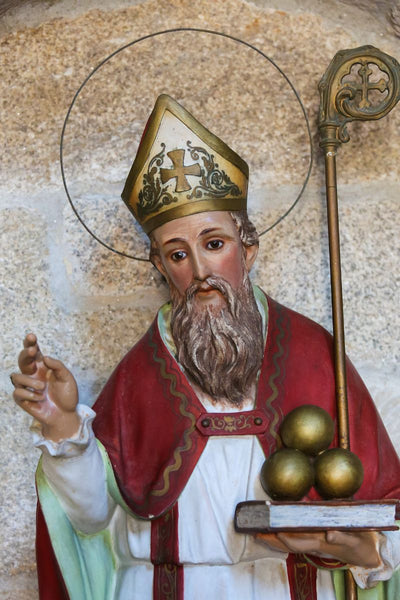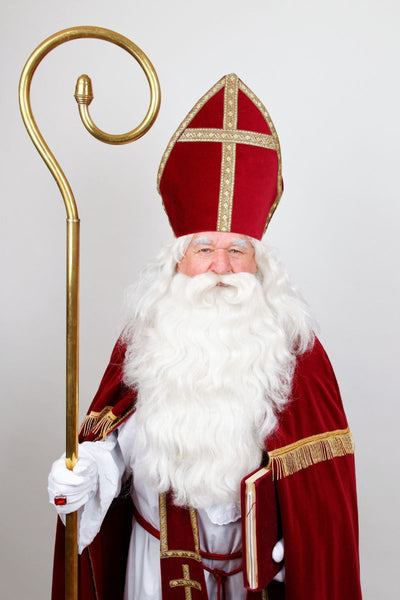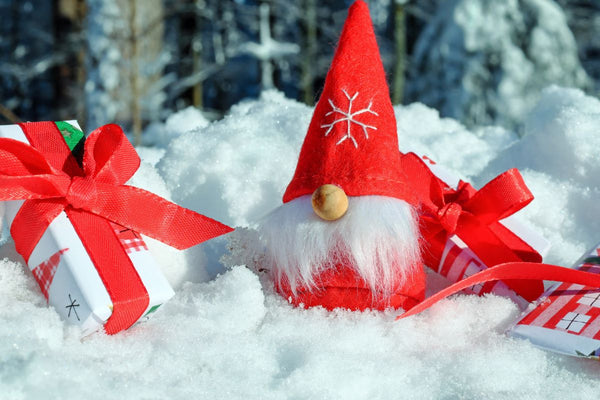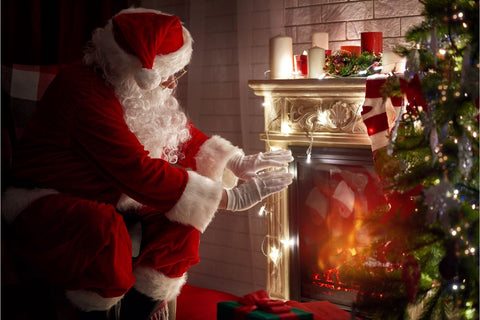The hearty "ho, ho, ho" laugh, red dress and flying sleigh - it’s Santa Claus! But who first invented Santa Claus? His character is derived from the image of Saint Nicholas but has changed over time. The modern image of Santa began to take shape from the 19th century onwards, and he acquired his final image at the beginning of the 20th century. His purpose and essence, however, remained the same - he is a character who personifies the goodness, generosity and magic of Christmas. In this article we will explore the history of Santa Claus and his importance in American holiday traditions. To find out more, we have to go back to the past!
The Origins of Santa Claus
The roots of today's Santa go back far into the past, where different legends and cultures have been intertwined over time. We will share the story of St. Nicholas, learn about the Dutch Sinterklaas and his journey to America, and meet the character of Father Christmas from England.
Saint Nicholas

The story of a kind man, named Nicholas of Myra, who gave gifts to children, dates back to the 4th century in Greece, in what is now Turkey. He was known for his generosity and kindness, especially towards children. Born wealthy, he became known for giving his fortune to the poor. The veneration of Nicholas began shortly after his death. His recognized goodness and miraculous works earned him the title of saint - St. Nicholas. Because he was so kind-hearted, other Christians began to imitate him at least once a year. Thus, he became one of the most popular saints of the Eastern Church. Saint Nicholas is a patron saint of a wide range of people, from children, sailors, travelers, judges, merchants, brewers, to toymakers and students.
His popularity grew from the 12th century onwards. During this period, there was a strong tradition of gift-giving in Europe, which was associated with the celebration of the winter solstice and other pagan holidays. The Church adopted these traditions and incorporated them into the celebration of the Feast of St. Nicholas. Gift-giving for Saint Nicholas Day had spread across most European countries. Originally, children were presented with small symbolic gifts such as fruit, nuts and homemade products.
Sinterklaas
In the 16th century during the Reformation, saints were abolished in all Protestant countries. Saint Nicholas remained popular only in the Netherlands, where his legend known as Sinterklaas was preserved. This is where the name, which today is known all over the world, comes from. The name Sinterklaas is a combination of the Dutch words "sint" (holy) and "klaas" (Nicholas - shortened to Klaus).

The image of St. Nicholas appeared in Jan Schenkman's Dutch book "St. Nicholas and his Servant" (1850). The story describes how Sinterklass arrives in Amsterdam by steamboat on December 5, the eve of St. Nicholas. He rides a white horse and leaves small gifts around the houses for hardworking children. Sinterklaas warns bad children that he can also take them away in his sack, if they misbehave.
This image of St. Nicholas or Sinterklaas was brought to America by the Dutch colonists in New Amsterdam (now New York City) in the 17th century.
The Evolution of Santa's Image
Different cultures celebrated different figures around the winter solstice. Over centuries, the images of Sinterklaas, Father Christmas and Saint Nicholas from Myra mixed, merged and developed into the main figure - Santa Claus, who brings smiles to children’s faces all around the world today. Throughout history, the current image of Santa Claus has been influenced by quite a few factors mostly in the 20th and 21st centuries. The most important ones are described below: the book "A History of New York", the song "A Visit from St. Nicholas" and the Coca-Cola commercial.
The Book "A History of New York"
The writer Washington Irving, who was fascinated by Dutch folklore, published his book "A History of New York" in 1809. This satirical work popularized the image of Sinterklaas in America. He was described as a kindhearted man, smoking a pipe, flying through the sky and delivering gifts to children through chimneys.
It is worth mentioning that in the same year, the New York Historical Society also decided to revive the traditions of the Dutch immigrants, including the legend of Sinterklaas, which the inhabitants of New Amsterdam had already begun to abandon.
The poem "A Visit from St. Nicholas"
The biggest turning point came with the publication of the famous poem "A Visit from St. Nicholas" in 1823. It was published anonymously, so there is no definitive evidence of the author, but it was presumably written by Clement Clark Moore, or Henry Livingston Jr. The song further strengthened the image of Santa Claus as we know him today, as it describes him riding a sleigh pulled by eight reindeer. It also records for the first time that Santa Claus arrives on the eve of Christmas.
‘Twas the night before Christmas, when all through the house
Not a creature was stirring, not even a mouse;
The stockings were hung by the chimney with care,
In hopes that St. Nicholas soon would be there;…
He spoke not a word, but went straight to his work,
And filled all the stockings; then turned with a jerk,
And laying his finger aside of his nose,
And giving a nod, up the chimney he rose;
The first modern visualization of Santa Claus came from Thomas Nast who drew the illustrations that accompanied the poem "A Visit from St. Nicholas". Nast, a political cartoonist for Harper's Weekly, first began drawing Santa Claus in 1863. The poem was then published in the magazine every year from 1863 to 1886, always accompanied by Nast's illustrations. Nast brought the elements and characters from the poem into his illustrations, and painted Santa’s suit in the now-iconic red color.
So we can say that the song "A Visit from St. Nicholas" and Thomas Nast's illustrations definitely played a huge role in creating a modern image of Santa Claus.
The Coca Cola Commercial
Using the image of Thomas Nast and poem “A Visit From St. Nicholas”, Haddon Sundblom drew Santa in red clothes with a white border in 1931. Sundblom drew a much kinder, warmer, and more symbolic Santa Claus, not as wild and stern-looking as the one Thomas Nast drew. The image was created for an advertising campaign for the well known Coca-Cola company. The goal of the campaign was to increase the sale of Coca-Cola even in winter. The advertisement showed Santa Claus smiling and holding a bottle of Coca-Cola first appeared in The Saturday Evening Post magazine, and soon after in Ladies Home Journal, National Geographic, The New Yorker and others. This campaign greatly contributed to the consolidation of Santa Claus’ image in popular culture in the 20th century. Sundblom's Santa was not just a simple illustration, but became a real icon.

Throughout the 20th century, American culture, with its commercialized Christmas movies, music and stores, greatly influenced the spread of the myth surrounding Santa Claus around the world.
Santa Claus and Gifting
Santa Claus, with his gift-giving and cheerful figure, today represents a symbol of joy, generosity and kindness. Throughout history, there are several possible reasons why Santa Claus brings gifts on Christmas Eve.

Christianity has had a strong influence throughout history. In Europe, the time around December was very important even before the rise of Christianity. During this period people celebrated winter solstice - the time when the day began to get longer. In the 4th century, December 25 was set as the date of Jesus' birth. Biblical legend says that at his birth, the Three Wise Men brought him gifts. Christians connected this event with the tradition of giving gifts at Christmas time.
The combination of these traditions - the gifting of Jesus, the celebration of the winter solstice and the charity of Saint Nicholas - had a profound effect on the Christmas celebration. Gift-giving has become a central part of the holiday, bringing joy and magic to children and adults.
Of course, the generalization of Santa Claus also brought some unfavorable effects. In some cultures the predominant Santa Claus has replaced older customs and traditions.
In any case, Santa Claus had a strong influence on holiday traditions around the world:
- He has become the main figure of gifting on Christmas Eve in the last two centuries.
- He has become a symbol of joy that the holidays bring us.
- He emphasizes charity, as he encourages helping people in need.
- He brought the unification of the celebration of Christmas around the world. The story of Santa Claus, who travels the world and gives gifts to children, is known to everyone.
The role of gift-giving naturally changed over time. Some societies emphasize the commercial aspect, while others focus on the importance of generosity and selflessness. Although traditions evolve, Santa's spirit remains the same – encouraging holiday spirit around the world.
Celebrating Santa Claus in American Culture
Santa Claus is a symbol of Christmas joy that decorates homes and cities during the holiday season. The figure of Santa Claus is very similar everywhere: A man dressed in a red suit with white fur and a long, white beard. He is usually holding a bag of gifts and waving his hand, or sitting on a sled.
His figure takes on a life of its own during the holidays, and is commonly used as:
- Christmas tree ornaments, which are small figurines of Santa Claus, are hung on the Christmas tree as festive adornments.
- Figurines that decorate homes and stores, where he is seen greeting visitors, climbing up ladders or carrying gifts.
- Various Christmas decorations for the home, such as Advent calendars, tablecloths and bed linen, serviettes, decorative pillows and blankets.
- City decorations often include illuminated figures of Santa Claus.
- Adults often dress up as Santa Claus to brighten up the holidays for children.

Santa Claus is an indispensable figure of the Christmas season. Because of this, it's no wonder that we've also started using him in all of our Christmas decorations.
Santa Claus Legend Today
Many people wonder, “Where is Santa Claus today and what is he doing?”. In his home at the North Pole, where there is lots of snow and ice, he enjoys some well-deserved time with Mrs. Claus. At the same time, he is eagerly preparing for the next Christmas Eve. His workshops make toys for all the children of the world throughout the year. He receives letters in which children write their wishes for Christmas presents. Many believe that the North Pole is a mysterious and inaccessible place and only Santa Claus and his reindeer can get there.

Reindeer
Santa Claus and Mrs. Claus are also accompanied by the loyal reindeer who patiently wait for Christmas Eve, when they will once again pull Santa's magic sleigh full of presents. But these are no ordinary reindeer. Each deer is unique, with an original name and personality. They have the ability to fly. On Christmas Eve Santa’s elves harness the sleigh and the deer then drag a sleigh full of toys along with Santa Claus across the sky. They are very fast, which is essential so that Santa Claus can deliver gifts to children all over the world in one night.
Dwarves
In addition to reindeer, dwarves also live at the North Pole. They manage and work in Santa's workshops. They make toys for children, they are very precise, quick and resourceful. They also help Santa organize the presents, prepare the sleigh for Christmas Eve, take care of the reindeer and help check letters from children asking for presents. Each dwarf has a unique personality and talents. Some are masters of wooden toys, others are skilled at sewing, while others have the imagination necessary to design new toys.
Santa Claus has a truly wonderful and superb team: the good Mrs. Claus, the loyal reindeer and the hard working elves. If you're going to write a letter to Santa this year, don't forget to say hi to his team too.
To Sum up …
Today, the whole world knows Santa Claus, but few would recognize him as the original figure of Saint Nicholas, the charitable bishop of Myra. His image has changed greatly over the centuries and adapted to different cultures, but the purpose has remained the same - gifting and happiness. Today's image of Santa Claus is the result of a century-long combination of various names and images, all of which are somehow related to Saint Nicholas and the holiday of Christmas. He changed from his former episcopal robes to a red jacket with white fur. The book "A History of New York", the poem "A Visit from St. Nicholas", Thomas Nast and his illustrations in the 19th century and then the famous Coca-Cola campaign in the early 20th century contributed to the consolidation of the modern image of the cheerful and generous man we know today.


